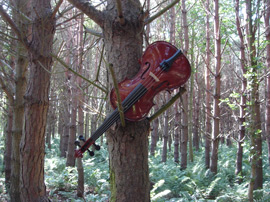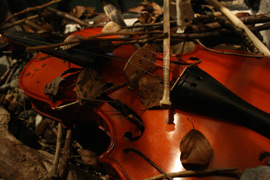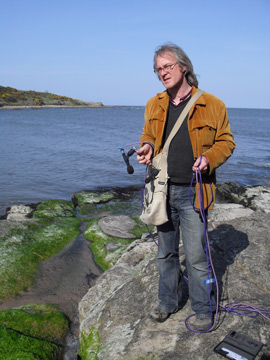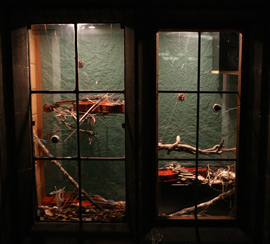Project 17 GOW
10th February- 10th April 2012
Bennett Hogg
Flow
flow plays with ways that energies interconnect and flow into one another – water flowing, sound waves moving through the air, fluctuating electrical signals through copper wire. Copper coils attached to the windows, when brought into contact with powerful magnets, transmit vibrations to the glass, playing back recordings of the eerie sounds made when violins are submerged in a fast flowing river, and the force of the passing water is sufficient to, as it were, “bow” the strings. Violins used to be trees, with water flowing through them; now water flows over them, causing them to sound, the same element resonating at a different register in the same material.
The window features three violins, juxtaposed with various materials that have been shaped or transformed by water – pebbles from Devil’s Water, the river near to Hexham where the violin recordings were made, wood eroded and shaped by water, or discoloured through spalting (a natural black and white patterning), detritus gathered and sorted by Devil’s Water in flood, as well as bleached animal bones from Howick beach. Howick is where the low frequency recordings that also feature in the installation were made – a deep tunnel through the cliffs that resounds with subsonic tones at high tide as waves compress and force columns of air through the rocks. These sounds cause physical vibrations that shake and loosen the precarious structures built up around the violins so that eventually the sound of water has a similar effect to water itself, eroding, displacing, sifting through, and depositing the material of the installation over a period of weeks.
Animal bones suggest the old Scottish ballad The Twa Sisters – a story known throughout Europe in one form or another (the Brothers Grimm version inspired the lyrics for Mahler’s song cycle Das Klagende Lied, and countless Germanic and Scandinavian version exist), where a murdered sister’s bones are made into a musical instrument by an itinerant musician which, when played, sings the story of her murder, and reveals that it was her own elder sister who killed her in a fit of jealousy. Such stories not only anticipate some of the mythical dimensions of sound recording, but – in its implication of metempsychosis - suggest another dimension at which energies may transfer between materials.
Holding the installation together, but at the same time destabilising it through another aspect of the action of water, are strands of copper wire, visually echoing the transducer coils on the window and the violin strings, but connected to pine cones. Resembling surreal harps, or some kind of fictional electrical technology, this element in the installation acts with the low frequency sounds to destabilise the materials; pine cones open and close according to humidity in the air, and so as they contract (in more humid conditions) they pull on the wires, displacing the objects they are attached to; when the cones dry out they open, the wires go slacker, making it easier for the sonic vibrations to dislocated the things attached.
flow is the first public action at the start of an eighteen month project called “Landscape Quartet”, funded by the Arts and Humanities Research Council, a combined creative practice and philosophical venture bringing together Bennett Hogg, Matthew Sansom, Sabine Vogel, and Stefan Östersjö.
Thanks for advice, ideas, and support to Bill Vine, Sabine Vogel, Irene Brown, John Ayers, Mick Hedley, Craig Wells, Magnus Williamson, David Clarke, Merrie Snell, and my Friday afternoon “Noises, Sounds, and Gestures” class at the International Centre for Music Studies, Newcastle University.



